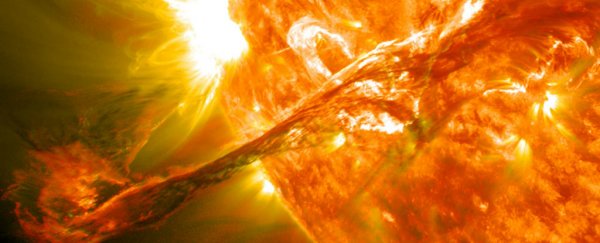The latest results from NASA's Kepler satellite may have finally solved the mystery of how the conditions for life were created on our younger Earth - and surprisingly it seems titanic eruptions from the Sun were the cause.
Far from damaging us, solar storms may have warmed the young Earth enough to house life as well as provided the chemical building blocks to create it.
Known as the faint young Sun paradox, the problem for astronomers was this: stars like our Sun brighten as they age, meaning when life started on Earth 3.5 billion years ago we would have only have received three quarters of the heat we get today. Far from being a place where life could arise, our young Earth would have been frozen solid.
One solution to this paradox was that Earth had a thicker atmosphere to trap more heat through a greenhouse effect. However recent results based on ancient rocks in Australia show that the air was actually only half as thick as today, making the problem even greater.
Young star temper tantrum
By surveying hundreds of thousands of stars, Kepler has been able to create a snapshot of Sun-like stars at different ages. The team found that while younger stars are indeed dimmer they are also prone to erupting in violent explosions more often.
These super solar flares can send billions of tonnes of energetic particles into space as a coronal mass ejection. If Earth is in the way they slam into our protective magnetic field, often visible to us as the aurora. Every century or so a particularly huge event will be unleashed that can cause serious damage to our electricity grid. A younger Sun could have been unleashing 10 of these a day.
These more violent storms would have collided with a weaker magnetic field on the younger Earth meaning the Northern Lights would have been seen down to southern states of the USA as well as all of Europe and China, while the Southern Lights would have reached South Africa and the bottom of Australia.
More importantly for life on Earth, the energy of the solar storms would have reached the atmosphere and powered chemical reactions turning otherwise inert nitrogen molecules into nitrous oxide and hydrogen cyanide.
Nitrous oxide, otherwise known as laughing gas, is an incredibly powerful greenhouse gas. Today we hear of the greenhouse gas carbon dioxide in our air, but if the young Earth had only a hundredth of the nitrous oxide that we have today of CO2 then enough heat would be trapped to keep water from freezing.
The fact that the same reactions can also create hydrogen cyanide, a key chemical building block for life as we know it, is especially exciting.
While life on Earth seems to have these powerful solar storms to thank for making conditions just right, the same can't be said for our neighbour Mars. The magnetic field on the red planet wasn't strong enough to prevent the atmosphere from being stripped away leaving it a frozen arid desert we know today.
This all means we can be even more picky when we start to search for life on recently discovered planets around other stars as they have to have the right combination of magnetic field strength and age of star to recreate the conditions on our younger Earth.
Surprisingly thanks to this result, we know that a violent star might be a good thing for kickstarting life.

Alan Duffy, Research Fellow, Swinburne University of Technology.
Swinburne University of Technology is a sponsor of ScienceAlert. Find out more about their innovative research.
![]()
This article was originally published on The Conversation. Read the original article.
![]()
